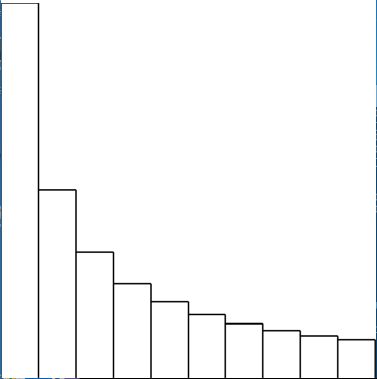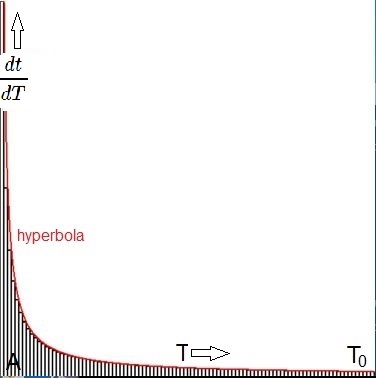
m --- = 1.0 0.9 0.8 0.7 0.6 0.5 0.4 0.3 0.2 0.1 m_0Furthermore, assume that the observer is using a gravitational clock. Then the (split) seconds, or centuries, or whatever units of that gravitational clock are inversely proportional to the values in the following sequence:
| m |2 |---| = 1.0 0.81 0.64 0.49 0.36 0.25 0.16 0.09 0.04 0.01 |m_0|But the observer does not know that his time units have been greater in the past; he thinks that they have been equal all the time. What could have been observed, however, is that atomic clocks have been running in a different way. To be more precise: it could have been observed that gravitational and atomic clocks have become running out of sync after some time. Now the question is: how many atomic time units are fitting into one gravitational time unit? Backwards in time, the gravitational time units gradually become greater (thanks to the inversely proportional) than the atomic time units. Thus there are fitting more and more atomic time units into one gravitational time unit. Sober thinking reveals that the amount of fit actually is equal to $(m_0/m)^2/(m_0/m)$ , leading to the following sequence:
m_0 --- = 1.0 1/0.9 1/0.8 1/0.7 1/0.6 1/0.5 1/0.4 1/0.3 1/0.2 1/0.1 mA sequence which has to be read from now (right) towards the past (left). Leading to the following graph:

Refining the calculations with a smaller unit elementary particle mass increase, say $1/100$, leads to the following graph:

Now it's not difficult to infer that all of these curves converge to an hyperbolic function of the form:
$$
\frac{\Delta t}{\Delta T} \to \frac{dt}{dT} = \frac{T_0-A}{T-A}
$$
Where $dt$ and $dT$ are the infinitesimal units of atomic time and gravitational time respectively; $T$ is gravitational time; $T_0$
is gravitational reference time, which is the "nowadays" timestamp - rightmost in the graphs - and $A$ is the gravitational timestamp
corresponding with the beginning, at the time when mass is created out of nothing - leftmost in the graphs. "General form" means that
there is no way to determine the timestamp $A$ theoretically. It must be determined from physical experiments, or by assuming that $A=$
Hubble time from Big Bang theory, or by careful biblical chronology,
or whatever.
|-------|-------|-------|-------|-------|-------|-------|-------|-------| : t 0123456789012345678901234567890123456789012345678901234567890123456789012 |--------|--------|--------|--------|--------|--------|--------|--------| : TSuppose the time units of the atomic clock $t$ are $8$ long and the time units of the gravitational clock $T$ are $9$ long. Then: $$ \frac{\mbox{1 unit of t}}{\mbox{1 unit of T}} = \frac{8}{9} $$ However, there are $9$ units of $t$ that fit into $8$ units of $T$ to measure the same time interval of $8 \times 9 = 72$ : $$ \frac{\mbox{#units of t}}{\mbox{#units of T}} = \frac{9}{8} $$
|m_0|2 |---| = 1/1.0 1/0.81 1/0.64 1/0.49 1/0.36 1/0.25 1/0.16 1/0.09 1/0.04 1/0.01 | m |Formally, with $\,\Delta m/m_0 = 1/10$ : $$ \Delta T = \Delta T_0 \left(\frac{m_0}{m}\right)^2 = \Delta T_0 \frac{m_0^2}{(k\,\Delta m)^2} \quad \mbox{with} \quad k = 10,9,8,7,6,5,4,3,2,1 $$ Summing these intervals from Creation until now leads to the following sum in the limit: $$ \sum \Delta T = \frac{\Delta T_0}{(\Delta m/m_0)^2} \sum_{k=1}^\infty \frac{1}{k^2} = \frac{\Delta T_0}{\Delta m/m_0}\left(\frac{\pi^2/6}{\Delta m/m_0}\right) $$ Which is only meant to show that the whole gravitational time interval from Creation until now is large but finite, though different from the time interval as observed by the person with a gravitational clock in their hands. In contrast, such is not the case for atomic time (harmonic sequence): $$ \sum \Delta t = \frac{\Delta t_0=\Delta T_0}{\Delta m/m_0} \sum_{k=1}^\infty \frac{1}{k} = \infty $$ As for the meaning of the factors before the sums, it is conjectured that: $$ \frac{\Delta T_0}{\Delta m/m_0} = T_0-A \quad : \quad \frac{1}{1/10} = 10 \quad , \quad \frac{1}{1/100} = 100 $$ Which therefore becomes more or less obvious by having a look at the pictures with the $10$ and $100$ pieces. In the picture with the $100$ pieces, it is indeed the way in which the $\color{red}{\mbox{red curve}}$ has been obtained, namely as : $y = 1/(\Delta m\cdot x)$ , as with $\,\Delta T_0\,$ and $\,m_0\,$ normed to $1$ .